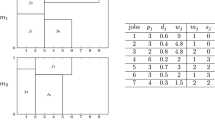Abstract
This paper considers online energy-efficient scheduling of virtual machines (VMs) for Cloud data centers. Each request is associated with a start-time, an end-time, a processing time and a capacity demand from a Physical Machine (PM). The goal is to schedule all of the requests non-preemptively in their start-time-end-time windows, subjecting to PM capacity constraints, such that the total busy time of all used PMs is minimized (called MinTBT-ON for abbreviation). This problem is a fundamental scheduling problem for parallel jobs allocation on multiple machines; it has important applications in power-aware scheduling in cloud computing, optical network design, customer service systems, and other related areas. Offline scheduling to minimize busy time is NP-hard already in the special case where all jobs have the same processing time and can be scheduled in a fixed time interval. One best-known result for MinTBT-ON problem is a g-competitive algorithm for general instances and unit-size jobs using First-Fit algorithm where g is the total capacity of a machine. In this paper, a \((1+\frac{g-2}{k}-\frac{g-1}{k^{2}})\)-competitive algorithm, Dynamic Bipartition-First-Fit (BFF) is proposed and proved for general case, where k is the ratio of the length of the longest interval over the length of the second longest interval for k>1 and g≥2. More results in general and special cases are obtained to improve the best-known bounds.






Similar content being viewed by others
References
Amazon EC2. http://www.amazon.com/ec2
Armbrust M et al (2009) Above the Clouds: A Berkeley View of Cloud Computing. Technical Report No UCB/EECS-2009-28
Beloglazov A, Abawajy J, Buyya R (2012) Energy-aware resource allocation heuristics for efficient management of data centers for cloud computing. Future Gener Comput Syst 28(5):755–768
Brucker P (2007) Scheduling algorithms, fifth edn. Springer, Berlin
Chen B, Hassin R, Tzur M (2002) Allocation of bandwidth and storage. IIE Trans 34:501–507
Flammini M, Monaco G, Moscardelli L, Shachnai H, Shalom M, Tamir T, Zaks S (2010) Minimizing total busy time in parallel scheduling with application to optical networks. Theor Comput Sci 411(40–42):3553–3562
Garey R, Johnson DS (1978) Computing and intractability: a guide to the theory of NP-completeness. Freeman, San Francisco
Graham RL (1969) Bounds on multiprocessing timing anomalies. SIAM J Appl Math 17(2):416–429
Hoogeveen JA, van de Velde SL, Veltman B (1994) Complexity of scheduling multiprocessor tasks with prespecified processor allocations. Discrete Appl Math 55(3):259–272. ISSN 0166-218X
Khandekar R, Schieber B, Shachnai H, Tamir T (2010) Minimizing busy time in multiple machine real-time scheduling. In: IARCS annual conference on Foundations of Software Technology and Theoretical Computer Science (FSTTCS 2010), pp 169–180
Kim K, Beloglazov A, Buyya R (2011) Power-aware provisioning of virtual machines for real-time cloud services, concurrency and computation: practice and experience, vol 23. Wiley, New York, pp 1491–1505. ISSN 1532-0626
Kleinberg J, Tardos E (2005) Algorithm Design, Pearson Education Inc
Kolen AWJ, Lenstra JK, Papadimitriou CH, Spieksma FCR (2007, online) Interval Scheduling: A Survey. 16 March 2007 in Wiley InterScience (www.interscience.wiley.com)
Kovalyov MY, Ng CT, Cheng E (2007) Fixed interval scheduling: models, applications, computational complexity and algorithms. Eur J Oper Res 178(2):331–342
Lee Y, Zomaya AY (2010, online) Energy Efficient Utilization Of Resource In Cloud Computing Systems. J Supercomput 19
Rao L, Liu X, Xie L, Liu WY (2010) Minimizing electricity cost: optimization of distributed Internet data centers in a multi-electricity-market environment. In: INFOCOM 2010
Shalom M, Voloshin A, Wong PWH, Yung FCC, Zaks S (2012) Online optimization of busy time on parallel machines. In: Theory and applications of models of computation. Lecture notes in computer science, vol 7287/2012, pp 448–460 (also in Technical Report)
Winkler P, Zhang L (2003) Wavelength assignment and generalized interval graph coloring. In: SODA, pp 830–831
Youseff L et al (2008) Toward a unified ontology of cloud computing. In: The proceedings of Grid Computing Environments workshop, GCE’08
Acknowledgements
This research is sponsored by the Natural Science Foundation of China (NSFC) Grant 61150110486.
Authors would like to thank anonymous reviewers of the Journal of Supercomputing. Their advice helped us improve the quality of the paper.
Author information
Authors and Affiliations
Corresponding author
Rights and permissions
About this article
Cite this article
Tian, W., Xiong, Q. & Cao, J. An online parallel scheduling method with application to energy-efficiency in cloud computing. J Supercomput 66, 1773–1790 (2013). https://doi.org/10.1007/s11227-013-0974-z
Published:
Issue Date:
DOI: https://doi.org/10.1007/s11227-013-0974-z




